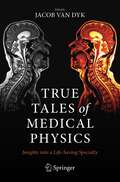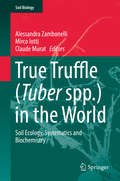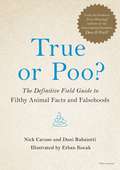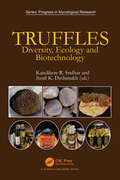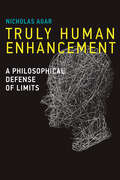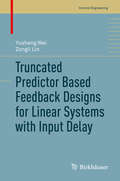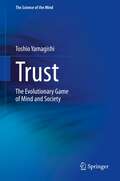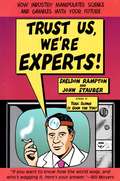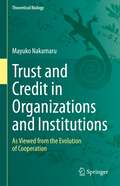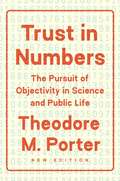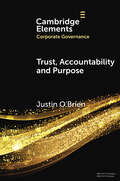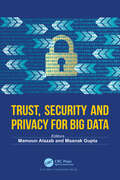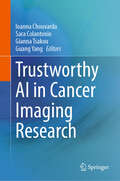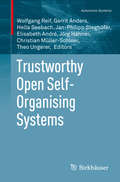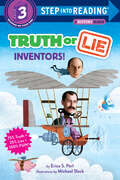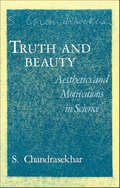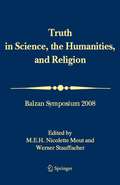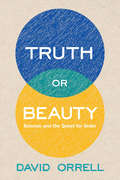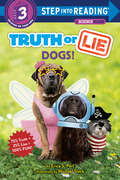- Table View
- List View
True Tales of Medical Physics: Insights into a Life-Saving Specialty
by Jacob Van DykSince the discovery of the x-ray over 125 years ago, scientists and medical professionals alike have harnessed the power of the atom to heal and protect. This book brings together an all-star cast of high-profile and award-winning scholars, introducing the general readership to an often unnoticed yet societally vital profession – medical physics. This collection of personal short stories offers an informal, behind-the-scenes glimpse into the lives of these esteemed professionals, encapsulating their transformative “aha” moments within a whimsical hodgepodge of instructive and inspiring anecdotes. They even pass on words of wisdom discovered from their diverse experiences throughout the academic, clinical, and commercial worlds. The wealth of information packed into these vignettes runs the gamut from practical career advice to lighthearted tales of humorous misadventure, providing a tremendous overview of the breadth and depth of medical physics as a career and discipline while imparting sage advice that extends well beyond the field. In his Foreword to this book Rafael Grossi, Director General of the International Atomic Energy Agency, provides his strong endorsement of the life-saving work carried out by medical physicists and the profession as a whole.From the general public to the budding student in search of career guidance, as well as young and seasoned practicing professionals, these thought-provoking, witty, and simply entertaining “untold stories” encourage the reader to reflect on and ponder the many enduring lessons born from unexpected life-turning events.
True Truffle (Tuber spp.) in the World
by Alessandra Zambonelli Mirco Iotti Claude MuratThis book focuses on the taxonomic diversity of the genus Tuber as economically important truffles. In contributions by internationally respected scientists, it examines truffle systematics, interactions with abiotic and biotic environments, strategies for spore dispersal, and molecular processes in truffles. Topics discussed include: evolutionary theories and phylogeny of Tuber species from Asia, Europe and North-America; the influence of climate on the natural distribution of Tuber species and fruiting body production, soil characteristics and vegetation in natural habitats; tools for tracing truffles in soil, host diversity, truffle inhabiting fungi and truffle-associated bacteria; and the relationships of small mammals and wild boars with truffles, as well as the smell of truffles. This book offers a valuable reference guide for all researchers working in the fields of mycology, ecology and the soil sciences, and will also be useful for farmers and foresters interested in truffle cultivation worldwide.
True or Poo?: The Definitive Field Guide to Filthy Animal Facts and Falsehoods (Does It Fart Series #2)
by Nick Caruso Dani RabaiottiFrom the scientist duo behind the New York Times bestselling sensation Does It Fart? comes a new illustrated compendium of animal facts and falsehoods, from the head-scratching to the repulsive! After Does It Fart? comes Number Two...a fully illustrated compendium of animal facts and falsehoods--the more repulsive the better. Do komodo dragons have toxic slobber? Is it true that a scorpion that sheds its tail dies of constipation? Speaking of poo, do rabbits really have a habit of, err, eating their own? And can you really get high from licking toads, or is that...fake newts?The answers to all these questions and more can be found in True or Poo?, a manual for disgusting and one-upping your friends and enemies for years to come.
True or Poo?: The Ultimate Guide to Animal Facts and Fibs (Does It Fart Ser. #2)
by Nick Caruso Dani RabaiottiThe toilet-tastic book that asks young readers to guess if animal facts are true...or POO?!Do wombats have cube-shaped poo?Do you eat spiders in your sleep?Do beetles pretend to be ant bottoms?In this hilariously helpful guide to which facts about the animal kingdom are true or false, you might be surprised to learn what's true ... and what's a big pile of poo! And you will find out a lot about that smelly stuff in this book too, from how it's made to which animals eat their own waste. (Yuck!)But will you be able to guess what's real and what's made up? Find out in this comical collection of weird habits, cool facts and sneaky myths about your favourite animals!This HILARIOUS book is the companion title to Does it Fart?
Truffles: Diversity, Ecology and Biotechnology (Progress in Mycological Research)
by Sunil K. Deshmukh Kandikere R. SridharTruffles are hypogeous ectomycorrhizal ascomycetous edible mushrooms distributed worldwide in terrestrial ecosystems, including deserts, as non-timber forest products. They are seasonal and have a short shelf life. Owing to their nutraceutical value, truffles are in high demand and valuable. Of the 180 or more species of truffles reported worldwide, only around 20 are commercially viable. Truffles: Diversity, Ecology and Biotechnology reviews the current advances in truffles from a historical perspective and covers ethnomycological profiles, habitats, ecology, geographical distribution, diversity, systematics, phylogeny, ultrastructure, sexual reproduction, cultivation, analytical techniques, and the impact of climate change and industrial applications on truffles. It also emphasizes the role of soil properties in the occurrence of truffles (e.g., Tuber spp.), their pathogens, product development and marketing. The contributors hail from academia and industries across the globe.
Truly Human Enhancement
by Nicholas AgarThe transformative potential of genetic and cybernetic technologies to enhance human capabilities is most often either rejected on moral and prudential grounds or hailed as the future salvation of humanity. In this book, Nicholas Agar offers a more nuanced view, making a case for moderate human enhancement -- improvements to attributes and abilities that do not significantly exceed what is currently possible for human beings. He argues against radical human enhancement, or improvements that greatly exceeds current human capabilities. Agar explores notions of transformative change and motives for human enhancement; distinguishes between the instrumental and intrinsic value of enhancements; argues that too much enhancement undermines human identity; considers the possibility of cognitively enhanced scientists; and argues against radical life extension. Making the case for moderate enhancement, Agar argues that many objections to enhancement are better understood as directed at the degree of enhancement rather than enhancement itself. Moderate human enhancement meets the requirement of truly human enhancement. By radically enhancing human cognitive capabilities, by contrast, we may inadvertently create beings ("post-persons") with moral status higher than that of persons. If we create beings more entitled to benefits and protections against harms than persons, Agar writes, this will be bad news for the unenhanced. Moderate human enhancement offers a more appealing vision of the future and of our relationship to technology.
Truly Human Enhancement: A Philosophical Defense of Limits (Basic Bioethics)
by Nicholas AgarA nuanced discussion of human enhancement that argues for enhancement that does not significantly exceed what is currently possible for human beings.The transformative potential of genetic and cybernetic technologies to enhance human capabilities is most often either rejected on moral and prudential grounds or hailed as the future salvation of humanity. In this book, Nicholas Agar offers a more nuanced view, making a case for moderate human enhancement—improvements to attributes and abilities that do not significantly exceed what is currently possible for human beings. He argues against radical human enhancement, or improvements that greatly exceed current human capabilities.Agar explores notions of transformative change and motives for human enhancement; distinguishes between the instrumental and intrinsic value of enhancements; argues that too much enhancement undermines human identity; considers the possibility of cognitively enhanced scientists; and argues against radical life extension. Making the case for moderate enhancement, Agar argues that many objections to enhancement are better understood as directed at the degree of enhancement rather than enhancement itself. Moderate human enhancement meets the requirement of truly human enhancement. By radically enhancing human cognitive capabilities, by contrast, we may inadvertently create beings (“post-persons”) with moral status higher than that of persons. If we create beings more entitled to benefits and protections against harms than persons, Agar writes, this will be bad news for the unenhanced. Moderate human enhancement offers a more appealing vision of the future and of our relationship to technology.
Truncated Predictor Based Feedback Designs for Linear Systems with Input Delay (Control Engineering)
by Zongli Lin Yusheng WeiThis monograph is the first of its kind to present innovative research results on truncated predictor feedback (TPF) designs for general linear systems with input delay. Beginning with a brief review of time delay systems, the first half of the book focuses on TPF with a constant feedback parameter. Both state feedback and output feedback are considered. It is established that TPF achieves stabilization in the presence of an arbitrarily large bounded delay if the open loop system is not exponentially unstable. Examples are presented to illustrate that TPF may fail to stabilize an exponentially unstable system when the delay is sufficiently large. Bounds on the delay are then established under which stabilization can be achieved. The second half of the book explores variations of the TPF laws designed with a non-constant feedback parameter to accommodate unknown delays and improve closed-loop performance. The authors employ a step-by-step approach to presenting the ultimate result on a completely delay-independent feedback law. Truncated Predictor Based Feedback Designs for Linear Systems with Input Delay will appeal to control engineers, control theorists, and graduate students studying control systems. This volume will also be a valuable resource for engineers and applied mathematicians interested in dynamic systems with time delays.
Trust
by Toshio YamagishiThis book is written around the central message that collectivist societies produce security, but destroy trust. In collectivist societies, people are connected through networks of strong personal ties where the behavior of all agents is constantly monitored and controlled. As a result, individuals in collectivist networks are assured that others will abide by social norms, and gain a sense of security erroneously thought of as "trust." However, this book argues that this security is not truly trust, based on beliefs regarding the integrity of others, but assurance, based on the system of mutual control within the network. In collectivist societies, security is assured insofar as people stay within the network, but people do not trust in the benevolence of human nature. On the one hand, transaction costs are reduced within collectivist networks, as once accepted into a network the risk of being maltreated is minimized. However, joining the network requires individuals to pay opportunity cost, that is, they pay a cost by forgoing potentially superior opportunities outside the security of the network. In this era of globalization, people from traditionally collectivistic societies face the challenge of learning how to free themselves from the security of such collectivistic networks in order to explore the opportunities open to them elsewhere. This book presents research investigating how the minds of individuals are shaped by the conflict between maintaining security inside closed networks of strong ties, and venturing outside of the network to seek out new opportunities.
Trust Us, We're Experts
by Sheldon Rampton John StauberFearless investigative journalists Sheldon Rampton and John Stauber ( Toxic Sludge Is Good for You! and Mad Cow U.S.A.) are back with a gripping expos of the public relations industry and the scientists who back their business-funded, anti-consumer-safety agendas. There are two kinds of "experts" in question--the PR spin doctors behind the scenes and the "independent" experts paraded before the public, scientists who have been hand-selected, cultivated, and paid handsomely to promote the views of corporations involved in controversial actions. Lively writing on controversial topics such as dioxin, bovine growth hormone, and genetically modified food makes this a real page-turner, shocking in its portrayal of the real and potential dangers in each of these technological innovations and of the "media pseudo-environment" created to obfuscate the risks. By financing and publicizing views that support the goals of corporate sponsors, PR campaigns have, over the course of the century, managed to suppress the dangers of lead poisoning for decades, silence the scientist who discovered that rats fed on genetically modified corn had significant organ abnormalities, squelch television and newspaper stories about the risks of bovine growth hormone, and place enough confusion and doubt in the public's mind about global warming to suppress any mobilization for action. Rampton and Stauber introduce the movers and shakers of the PR industry, from the "risk communicators" (whose job is to downplay all risks) and "outrage managers" (with their four strategies--deflect, defer, dismiss, or defeat) to those who specialize in "public policy intelligence" (spying on opponents). Evidently, these elaborate PR campaigns are created for our own good. According to public relations philosophers, the public reacts emotionally to topics related to health and safety and is incapable of holding rational discourse. Needless to say, Rampton and Stauber find these views rather antidemocratic and intend to pull back the curtain to reveal the real wizard in Oz. This is one wake-up call that's hard to resist.
Trust and Confidence at the Interfaces of the Life Sciences and Society: Does the Public Trust Science? A Workshop Summary
by Helaine E. ResnickDoes the public trust science? Scientists? Scientific organizations? What roles do trust and the lack of trust play in public debates about how science can be used to address such societal concerns as childhood vaccination, cancer screening, and a warming planet? What could happen if social trust in science or scientists faded? These types of questions led the Roundtable on Public Interfaces of the Life Sciences of the National Academies of Sciences, Engineering, and Medicine to convene a 2-day workshop on May 5-6, 2015 on public trust in science. This report explores empirical evidence on public opinion and attitudes toward life sciences as they relate to societal issues, whether and how contentious debate about select life science topics mediates trust, and the roles that scientists, business, media, community groups, and other stakeholders play in creating and maintaining public confidence in life sciences. Does the Public Trust Science? Trust and Confidence at the Interfaces of the Life Sciences and Society highlights research on the elements of trust and how to build, mend, or maintain trust; and examine best practices in the context of scientist engagement with lay audiences around social issues.
Trust and Credit in Organizations and Institutions: As Viewed from the Evolution of Cooperation (Theoretical Biology)
by Mayuko NakamaruThis book shows that evolutionary game theory can unravel how mutual cooperation, trust, and credit in a group emerge in organizations and institutions. Some organizations and institutions, such as insurance unions, credit unions, and banks, originated from very simple mutual-aid groups. Members in these early-stage mutual-aid groups help each other, making rules to promote cooperation, and suppressing free riders. Then, they come to “trust” not only each other but also the group they belong to, itself. The division of labor occurs when the society comes to have diversity and complexity in a larger group, and the division of labor also requires mutual cooperation and trust among different social roles. In a larger group, people cannot directly interact with each other, and the reputation of unknown people helps other decide who is a trustworthy person. However, if gossip spreads untruths about a reputation, trust and cooperation are destroyed. Therefore, how to suppress untrue gossip is also important for trust and cooperation in a larger group. If trustworthiness and credibility can be established, these groups are successfully sustainable. Some develop and evolve and then mature into larger organizations and institutions. Finally, these organizations and institutions become what they are now. Therefore, not only cooperation but also trust and credit are keys to understanding these organizations and institutions.The evolution of cooperation, a topic of research in evolutionary ecology and evolutionary game theory, can be applied to understanding how to make institutions and organizations sustainable, trustworthy, and credible. It provides us with the idea that evolutionary game theory is a good mathematical tool to analyze trust and credit. This kind of research can be applied to current hot topics such as microfinance and the sustainable use of ecosystems.
Trust in Numbers: The Pursuit of Objectivity in Science and Public Life
by Theodore M. PorterA foundational work on historical and social studies of quantificationWhat accounts for the prestige of quantitative methods? The usual answer is that quantification is desirable in social investigation as a result of its successes in science. Trust in Numbers questions whether such success in the study of stars, molecules, or cells should be an attractive model for research on human societies, and examines why the natural sciences are highly quantitative in the first place. Theodore Porter argues that a better understanding of the attractions of quantification in business, government, and social research brings a fresh perspective to its role in psychology, physics, and medicine. Quantitative rigor is not inherent in science but arises from political and social pressures, and objectivity derives its impetus from cultural contexts. In a new preface, the author sheds light on the current infatuation with quantitative methods, particularly at the intersection of science and bureaucracy.
Trust, Accountability and Purpose: The Regulation of Corporate Governance (Elements in Corporate Governance)
by Justin O'BrienThe collapse of trust can be found across all of our institutions but most of all in finance. This Element seeks to answer an existential question: how to rebuild trust in distrusting times? Integrity, responsibility and accountability must be embedded into corporate mission statements, values and codes of conduct. Through organisational and regulatory design across five interlocking themes - legal, regulatory, managerial, ethical and social. What is required is substantive rather than technical compliance; warranted rather than stated commitment to high ethical standards; effective deterrence strategies; enhanced accountability; and a shared commitment to risk within negotiated, binding and enforceable parameters.
Trust, Security and Privacy for Big Data
by Mamoun AlazabData has revolutionized the digital ecosystem. Readily available large datasets foster AI and machine learning automated solutions. The data generated from diverse and varied sources including IoT, social platforms, healthcare, system logs, bio-informatics, etc. contribute to and define the ethos of Big Data which is volume, velocity and variety. Data lakes formed by the amalgamation of data from these sources requires powerful, scalable and resilient storage and processing platforms to reveal the true value hidden inside this data mine. Data formats and its collection from various sources not only introduce unprecedented challenges to different domains including IoT, manufacturing, smart cars, power grids etc., but also highlight the security and privacy issues in this age of big data. Security and privacy in big data is facing many challenges, such as generative adversary networks, efficient encryption and decryption algorithms, encrypted information retrieval, attribute-based encryption, attacks on availability, and reliability. Providing security and privacy for big data storage, transmission, and processing have been attracting much attention in all big data related areas.The book provides timely and comprehensive information for researchers and industry partners in communications and networking domains to review the latest results in security and privacy related work of Big Data. It will serve computer science and cybersecurity communities including researchers, academicians, students, and practitioners who have interest in big data trust privacy and security aspects. It is a comprehensive work on the most recent developments in security of datasets from varied sources including IoT, cyber physical domains, big data architectures, studies for trustworthy computing, and approaches for distributed systems and big data security solutions etc.
Trustworthy AI in Cancer Imaging Research
by Ioanna Chouvarda Guang Yang Sara Colantonio Gianna TsakouThe book covers multiple aspects and challenges, from legal to technical and validation, in the emerging topic of AI in cancer imaging, bringing together the experience of top researchers and flagship projects. The aim of this book is to address the important questions: &“How to design AI that is trustworthy&”, and &“How to validate AI trustworthiness&” in the scope of AI for cancer imaging research. The book discusses overall considerations and the generation of a framework; preparing for trustworthy AI, including the data and metadata for quality, transparency and traceability; implementing trustworthy AI with algorithms and Decision Support Systems; and validating trustworthy AI. This is an ideal resource for researchers from technical and clinical research sites, postgraduate students, and healthcare professionals in cancer imaging and beyond.
Trustworthy Open Self-Organising Systems
by Wolfgang Reif Gerrit Anders Hella Seebach Jan-Philipp Steghöfer Elisabeth André Jörg Hähner Christian Müller-Schloer Theo UngererThis booktreats the computational use of social concepts as the focal point for therealisation of a novel class of socio-technical systems, comprising smartgrids, public display environments, and grid computing. Thesesystems are composed of technical and human constituents that interact witheach other in an open environment. Heterogeneity, large scale, and uncertaintyin the behaviour of the constituents and the environment are the rule ratherthan the exception. Ensuringthe trustworthiness of such systems allows their technical constituents tointeract with each other in a reliable, secure, and predictable way while theirhuman users are able to understand and control them. "TrustworthyOpen Self-Organising Systems" contains a wealth of knowledge, fromtrustworthy self-organisation mechanisms, to trust models, methods to measure auser's trust in a system, a discussion of social concepts beyond trust, andinsights into the impact open self-organising systems will have on society.
Truth Machine: The Contentious History of DNA Fingerprinting
by Michael Lynch Simon A. Cole Kathleen Jordan Ruth McnallyDNA profiling--commonly known as DNA fingerprinting--is often heralded as unassailable criminal evidence, a veritable "truth machine" that can overturn convictions based on eyewitness testimony, confessions, and other forms of forensic evidence. But DNA evidence is far from infallible. It is subject to the same possibilities for error--in sample collection, forensic analysis, and clerical record keeping--as any other aspect of criminal justice practice. Truth Machine traces the controversial history of DNA fingerprinting by looking at court cases in the United States and United Kingdom beginning in the mid-1980s, when the practice was invented, and continuing until the present. Using interviews, observations of courtroom trials and laboratory processes, and documentary reconstruction, the authors provide a nuanced, theoretically sophisticated, and original ethnographic account of DNA fingerprinting and its evolution. Ultimately, Truth Machine presents compelling evidence of the obstacles and opportunities at the intersection of science, technology, sociology, and law.
Truth Or Lie: Inventors! (Step into Reading)
by Erica S. PerlBudding inventors and science fair nerds will love hunting down the TRUTH about some groundbreaking inventions--past and present--and the people behind them in this innovative early reader.The computer mouse was invented by Steve Jobs, right? That's a LIE! The TRUTH is, it was invented by a man you've probably never heard of named Doug Englebart!! Though this engaging early reader is 100% fun, 25% of it is FALSE! In a unique Q&A format, proficient readers are quizzed about inventions and their inventors to see if they can separate facts from "lies." The book's mascot--the Truth Sleuth--guides readers through this funny and fact-packed book, which features photos and illustrations of a wide variety of inventions--from the printing press to velcro to a light-up soccer ball. With funny, kid-appealing art by Michael Slack.Step 3 Readers feature easy-to-follow plots about popular topics, for children who are ready to read on their own.
Truth and Beauty: Aesthetics and Motivations in Science
by S. Chandrasekhar"What a splendid book! Reading it is a joy, and for me, at least, continuing reading it became compulsive. . . . Chandrasekhar is a distinguished astrophysicist and every one of the lectures bears the hallmark of all his work: precision, thoroughness, lucidity. "—Sir Hermann Bondi, Nature The late S. Chandrasekhar was best known for his discovery of the upper limit to the mass of a white dwarf star, for which he received the Nobel Prize in Physics in 1983. He was the author of many books, including The Mathematical Theory of Black Holes and, most recently, Newton's Principia for the Common Reader.
Truth and Beauty: Aesthetics and Motivations in Science
by S. ChandrasekharSeven lectures detailing the author&’s thoughts on motivations in the pursuit of science and patterns of scientific creativity.&“What a splendid book! Reading it is a joy, and for me, at least, continuing reading it became compulsive…. Chandrasekhar is a distinguished astrophysicist and every one of the lectures bears the hallmark of all his work: precision, thoroughness, lucidity.&” —Sir Hermann Bondi, Nature Does aesthetics play a role in science? Can it be that science is given impetus by a search for beauty? What relation exists between the beauty of an idea and its power to account for some aspect of the natural world? Throughout his distinguished career, S. Chandrasekhar has given time and thought to these questions and to their implications for his work and the work of others. Truth and Beauty gathers the fruits of his meditations. Heisenberg, observes Chandrasekhar, spoke eloquently of the sheer force of his aesthetic experience when he discovered the key to the quantum theory. Weyl characterized the process of working out his gauge theory as a choice of the beautiful over the true, a choice strongly supported by subsequent research. Einstein also felt the aesthetic power underlying his discoveries. While most of the seven essays in Truth and Beauty deal generally with the nature of science and the process of research, two essays explore the work of individuals. —Edward Arthur Milne and Arthur Stanley Eddington The late S. Chandrasekhar was best known for his discovery of the upper limit to the mass of a white dwarf star, for which he received the Nobel Prize in Physics in 1983. He was the author of many books, including The Mathematical Theory of Black Holes and, most recently, Newton's Principia for the Common Reader.
Truth in Science, the Humanities and Religion
by International Balzan FoundationThe question of the meaning of "truth" is central to many areas of contemporary debate, whether between those subscribing to a post-Enlightenment view of the world and those who seek fundamental truth in religious texts, or between those maintaining that there are absolute truths and those believing facts to be social constructs. For some, the ultimate truth is revealed through religious faith and textual authority. Can this view be reconciled with an evidence-based, materialist, post-Enlightenment perspective of the truth as embraced by the natural sciences? If religion holds the key to the truth, which religion and which truths? What is the attitude of the humanities to the meaning of truth? Truth in the sciences and the humanities as well as in religion and theology is the central theme of this book based on the proceedings of a conference organized by the International Balzan Foundation. It contains the speakers' lectures, the corresponding reactions of the invited panel members as well as the general discussions. The reader can familiarize himself with views ranging from philosophy to religion, from mathematics, physics and cosmology to biological sciences, history, sociology and economics. The exceptional wide scope of the book, comprising arguments about truth in the sciences, the humanities as well as religion and theology together with the discussions between representatives of all these different fields, means that it is of interest to a professional as well as a general readership.
Truth or Beauty
by David OrrellFor millennia, scientists and philosophers have strived to show that the universe is governed by a few simple principles. These principles are not derived from science. They do not come from looking through telescopes or carefully examining the results generated by particle colliders. Rather,they are based on aesthetic laws and concepts such as symmetry, beauty, and unity. Scientist and author David Orrell considers how aesthetics have influenced the models we create in hopes of explaining our universe. His book begins with a look at early scientific thinkers, from the ancient Greeks to Galileo. The ancients constructed a concept of the world based on musical harmony;later thinkers overturned this concept, but replaced it with a program, based on Newton's "rational mechanics," to reduce the universe to a few simple equations. Orrell then turns to the scientific program of the twentieth century, culminating in supersymmetric string theory, which was againinfluenced by deep aesthetic principles. In a final section of the book, Orrell broadens his discussion to other fields of research, including economics, architecture, and health. Recent history has shown us what happens when financiers rely on a model of economics that resembles what a good theory"should look like" rather than the messy reality of human interaction. Ideas of mathematical elegance have inspired, entranced, and "sometimes misled" thinkers in their desire to find the laws that govern our universe. Orrell evaluates these aesthetic principles as a means of understanding the structure of the universe - let alone messy human society - and questionswhether they reflect an accurate way to understand our world. Truth or Beauty comes at an interesting period, when the multi-billion-dollar Large Hadron Collider in Switzerland has been designed to test the existence of exotic phenomena such as supersymmetric particles. Will these too turn out to be nothing more than a beautiful illusion?
Truth or Lie: Dinosaurs! (Step into Reading)
by Erica S. PerlDinosaur fanatics will love hunting down the TRUTH about their favorite prehistoric reptiles in this innovative new Science Reader series.Tyrannosaurus rex's closest living relative is the alligator, right? That's a LIE! The TRUTH is, the massive carnivore was actually more closely related to chickens!! Though this engaging early reader is 100% fun, 25% of it is FALSE! In a unique question-and-answer format, proficient readers are quizzed about dinosaurs to see if they can separate facts from "lies." The book's mascot--the Truth Sleuth--guides readers through this funny and fact-packed Step 3 Reader, which features photos and illustrations of dinosaurs and fossils, with funny, kid-appealing art by Michael Slack.Step 3 Readers feature engaging characters in easy-to-follow plots about popular topics, for children who are ready to read on their own.
Truth or Lie: Dogs! (Step into Reading)
by Erica S. PerlYoung dog lovers will enjoy sniffing out the TRUTH about their favorite animals in this innovative Step 3 nonfiction reader.Dogs don't sniff each other's butts as often as we think, right? That's a LIE! The TRUTH is, dogs almost always greet each this way! It gives them lots of information about other dogs. Though this engaging early reader is 100% fun, 25% of it is FALSE! In a unique Q&A format, proficient readers are quizzed about dogs to see if they can separate facts from "lies." The book's mascot--the Truth Sleuth--guides readers through this funny and fact-packed book, which features photos and illustrations of a wide variety of canines.Step 3 Readers feature easy-to-follow plots about popular topics, for children who are ready to read on their own.
